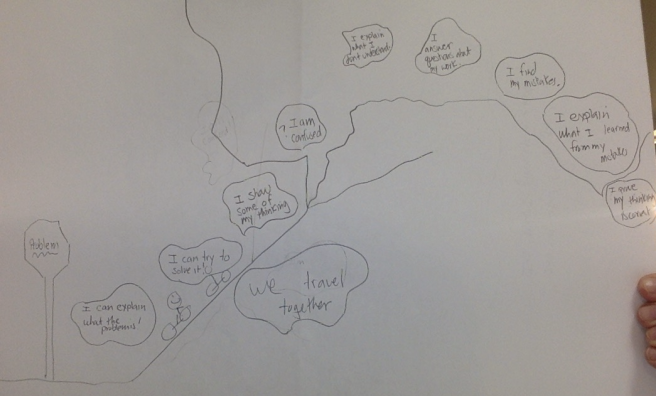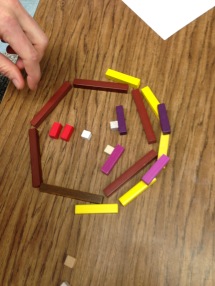I have been thinking a lot about productive struggle. What does it really mean to struggle productively? This is what I found when I Googled the words:
 : achieving or producing a significant amount or result.
: achieving or producing a significant amount or result.
That seems pretty straight forward. How about “struggle”?

Yikes! I would like to think we can avoid violence in math class. Could the purpose of productive struggle in math class be to “strive to achieve or attain something significant in the face of difficulty or resistance”?
This week, I facilitated Math Learning Labs with our elementary school teachers. It might have been my favorite week of school so far. Learning labs are a time for us to learn and grow together. Last week, I wrote about my experience with the Kindergarten teachers. Today, I get to share what happened with the third grade teachers.
Once a week, since early September, I have been co-teaching with Mrs. Watkins. We have been trying to help her third grade students build stamina for problem solving. You can read more about that here. Since the grade level meeting was going to take place in Mrs. Watkin’s building (we live in a small rural district so each elementary school takes a turn hosting a meeting), I wanted the learning lab to meaningful for her. We discussed what kind of experience would be beneficial for the teachers AND also for Mrs. Watkin’s students. We decided that we would like to give the students an opportunity to justify their thinking and the teachers an opportunity to support productive struggle.
Here is what we came up with for an agenda:

We started by reading two blog posts about the Hundreds Face Challenge, one written by Malke Rosenfeld and one written by me.
Then, I gave the teachers a collection of statements about productive struggle. I got most of these statements from NCTM’s recommended teaching practice, Support Productive Struggle in Mathematics. I added some of the statements that Mrs. Watkins and I had discussed with her students. 
I asked the teachers to arrange the statements so they showed a progression or “road map” through productive struggle. This is what they did:
Then, we jumped right into building our own Hundreds Faces.
Some people started by counting out a collection of rods that equaled 100 and then building and adjusting as they went.
Others, started a design and kept track as they went:
Everyone was able to build and justify a hundreds face:
After we built our hundreds faces, we shared our thinking and reflected about how our approaches were similar and different. I shared how I had figured out that if I could rearrange my Cuisinaire rods into a 10 x 10 square than I could prove that I used the equivalent of 100. I wondered, would you always be able to make a 10 x 10 square out of any hundreds face? Could you make a 25 x 4 rectangle? They wondered these things too. We agreed to explore these questions further during our next unit.
Next month, we will be using Muffle’s Truffle, one of the mini units in Cathy Fosnot’s Context for Learning Math series, to kick off our third grade exploration of the relationship between arrays, addition, multiplication, squares, and rectangles. This will be a perfect time to explore our questions further.
As we revisited our maps of productive struggle. I asked, “did you experience any of these statements while you were building your hundreds face?” The teachers responded with many connections:
“We all solved problems.”
“We had to find our own mistakes.”
“We had to prove and justify our thinking.”
“We asked a lot of questions.”
Then, they started to have a really interesting conversation about whether the math leverages the creativity or vice versa.
Have a listen:
After this conversation, I asked the teachers to each make their own individual map of productive struggle. We didn’t have a lot of time, but I was hoping they would transfer whatever meaning they had constructed to a sketch. We each thought of our journey through productive struggle differently:




After we shared our maps, we brainstormed some questions that we could have in our back pockets as we interviewed the third graders about their hundreds faces. Here are some that we came up with:
- How do you know if this is equal to 100?
- Can you show me?
- Is there another way we can figure if it is 100?
- What does that (having too many or too few) mean?
- What do you need to do next?
Finally, we went into third grade to see whether or not the students could justify their hundreds faces. As we circulated the room, the kids were eager to share all their strategies with us. Unfortunately, most of the video footage from this experience is full of so much math talk that it is hard to discern who is saying what. Fortunately, there is a TON of wonderful math talk happening in this classroom. Here is a sample of an exchange between a teacher and student:
S: “Right now I am at 81.”
T: “and you have to get to how many?”
S: “100”
T: “so how many more do you need?”
Below, you can see some sample faces with their justifications. Can you find the math in the pictures?
Right before we were wrapping up with the kids, our district curriculum coordinator managed to capture her conversation with a student who was navigating his way through some big ideas about area, geometry, and multiplication. Take a look:
If the purpose of productive struggle in math class is to “strive to achieve or attain something significant in the face of difficulty or resistance”, was Marshall engaged in productive struggle? What did he produce that was significant? I noticed that he produced a pretty significant statement regarding the classification of the shape that he created:
“It’s a rectangle!”
I wonder which was more significant; the statement he made or the resistance that got him to a place where he could claim it? Think about the questions/statements that Nancy contributed to her conversation with Marshall:
- What is this? Can you tell me about what you made here?
- How do you know it is a square?
- Rephrase: “So, anything with four edges and four ends…”
- How do you know that those are equal edges?
- Prove it to me.
- Oh, you are measuring with your hands. What if I said show me with the rods?
Now, think about what would have happened if Nancy had never asked the first question. What if Marshall left class thinking he had built a square? Teachers often admit to me that their biggest concern about allowing students to experience disequilibrium is that the student might leave the classroom confused about something. What if they leave thinking the wrong answer is actually the right answer? What if they leave my classroom not knowing all the answers?
I usually respond that the difference between the struggle being productive and unproductive is the teacher’s level of awareness. If you know your students have partially formed understandings then you can revisit and explore these with carefully planned questions and problems. But, how do we know what our students don’t know?
We ask. Then, listen. I mean really listen.



















Wonderful! Brilliant idea to link the hundred face activity with the idea of productive struggle – so much more learning – for the students, but for all the adults involved, including us readers!
LikeLiked by 1 person
Thank you Simon! It was a wonderful experience. All of the teachers were very excited about trying the activity with their students and we all benefited from deeply exploring the idea of struggle. One of the third grade teachers e-mailed me after the lab and said, “I wish I engaged in more productive struggle when I was in school. I would have been more successful.” Tomorrow, the third graders are creating their paper hundred faces and hanging them in from the hallway ceiling. I can’t wait to see them.
LikeLiked by 1 person